Longshoremen Talks With Port Terminal Operators And Ocean Carriers Over Work Rules At Port Of New York And New Jersey Nearing Critical Deadline

The sense of relief felt earlier this month because the longshoremen’s union and negotiators for ocean carriers and port terminal operators reached a tentative umbrella, or so-called coastwide master, contract is fading.
On Feb. 1, the International Longshoremen’s Association, or ILA, which is part of the AFL-CIO, and the U.S. Maritime Alliance, or USMX, which represents owners of ocean-going freighters and terminals that load and unload those vessels, agreed on a tentative contract covering all 15 major ports from Maine to Texas.
That was good news for the nation’s retailers who warned that a strike could cost the nation’s economy more than $1 billion per day.
ILA members must vote on the pact, presumably next month, and approval is expected. Until that approval is approved, it was agreed that there would be no work stoppage.
So much for the good news.
Even if ILA members approve the master contract, it only goes into effect if local contract issues specific to individual ports are resolved, issues that include work rules and pensions. None of the local negotiations are as challenging as those of the Port of New York and New Jersey, where labor costs are vastly higher than at other U.S. ports. Negotiators have given themselves until March 1 to agree on tentative local pacts, according to the Journal of Commerce.
The talks aren’t going well, according to a person familiar with the talks, who said there were two reasons for the lack of progress.
One reason has to do with the fact that the USMX was unable to achieve any cost reductions for its members in the master contract.
The tentative master contract would hike the $32 hourly base pay for experienced ILA members to $35 in three steps, according to the Journal of Commerce. Newly hired ILA members will be able to reach top scale in six years instead of the current nine years. More importantly, container royalties will be at least the $211 million paid in 2011, with the USMX and ILA splitting anything over that amount. The USMX had wanted to cap and then phase out container royalties altogether, but it failed -- despite the fact that very few current ILA members, many of whom make more than $100,000 per year, have ever experienced any financial impact from the introduction of containers.
“As far as carriers are concerned, they don’t feel like they reduced their operating costs” in the tentative master contract, an industry source who works in retail company logistics and is familiar with the negotiations said.
“That’s a big concern. The USMX could try to get [reduced operating costs] back in local negotiations. The question is how hard does management push to recover in the local negotiations what they gave away in the national agreement since they folded on the container royalty issue?”
Another possible reason has to do with pressure on the ILA from the AFL-CIO to take a tough position in local negotiations, the industry source said.
“There are other folks involved in these talks [than just the ILA and the USMX],” the industry source said. “My guess is that the AFL-CIO leadership has been putting pressure on the ILA.”
A strike at the Port of New York and New Jersey supported by longshoremen at other ports along the East Coast and the Gulf Coast would affect about 35 percent of U.S. imports.
A strike would have hit the New York-New Jersey area particularly hard. About 3,250 longshoremen load and unload boats on ports in the area. Port activity directly supports nearly 200,000 jobs in the New York area alone. A one-week dockworkers strike would cost the region an estimated $110 million in economic output and $136 million in personal income. Even without sympathy strikes by dockworkers in other ports, a New York-area job action would have cost the U.S. $1 billion to $2 billion per day in economic activity.
Moreover, a strike would have hammered the nation's fragile economic recovery, because consumers, who constitute about 70 percent of the U.S. economy, would have to absorb the extra cost of goods as a result of higher transportation charges.
© Copyright IBTimes 2024. All rights reserved.






















